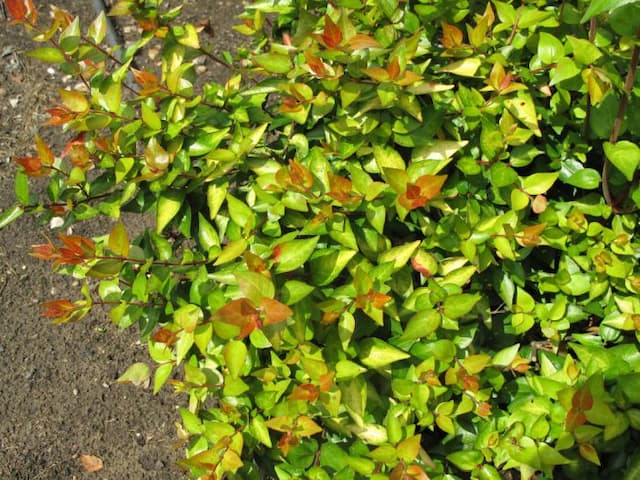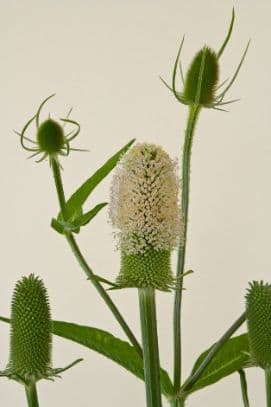Little Honey Honeysuckle Lonicera crassifolia 'Little Honey'

ABOUT
Little Honey is a distinctive plant known for its compact form and ornamental value. It sports small, glossy, and leathery leaves that have a rounded shape. The intense green foliage often has a radiant sheen, creating a contrast against its soft, creamy-yellow margins that give the appearance of a delicate sunny outline. As the seasons change, the leaves may assume a more golden hue, adding warmth to the plant’s overall appearance. This variety of honeysuckle is also admired for its fragrant flowers. The blooms are tubular in shape and usually emerge in a soft, creamy white color, which together with their sweet aroma, can attract hummingbirds and other pollinators. Following the blooming period, Little Honey may produce berries that provide an additional visual interest and can serve as a food source for birds. The branching of Little Honey is dense and twiggy, forming a pleasantly rounded shape that contributes to its overall lush and full appearance. Due to its attractive and versatile nature, Little Honey is often utilized in gardening and landscaping to create colorful borders, serve as accent plants, or be planted in containers where their charming qualities can be displayed prominently.
About this plant
 Names
NamesFamily
Caprifoliaceae
Synonyms
Little Honey Honeysuckle, Dwarf Honeysuckle
Common names
Lonicera crassifolia.
 Toxicity
ToxicityTo humans
Little Honey, as many other members of the honeysuckle family, may contain saponins which can be mildly toxic to humans if ingested. Eating parts of the plant can lead to symptoms such as vomiting, diarrhea, and abdominal pain. In severe cases, large ingestions might result in more serious toxicity.
To pets
Little Honey honeysuckle is considered to be toxic to pets, especially dogs and cats. Ingesting the plant can cause symptoms such as gastrointestinal upset, diarrhea, vomiting, and could potentially result in more serious illness if a significant amount was ingested. If you suspect your pet has consumed Little Honey honeysuckle, it is advisable to contact a veterinarian.
 Characteristics
CharacteristicsLife cycle
Perennials
Foliage type
Deciduous
Color of leaves
Green
Flower color
Yellow
Height
1-2 feet (0.3-0.6 meters)
Spread
2-3 feet (0.6-0.9 meters)
Plant type
Shrub
Hardiness zones
5
Native area
China
Benefits
 General Benefits
General Benefits- Attractive Foliage: 'Little Honey' has vibrant green and golden-yellow leaves that add color to the garden.
- Compact Size: It is a dwarf variety suitable for small garden spaces or containers.
- Easy to Grow: This plant is low-maintenance, making it a good choice for beginner gardeners.
- Drought Tolerance: Once established, it can handle periods of drought, reducing the need for frequent watering.
- Diverse Planting Options: It can be used in borders, as a groundcover, or in rock gardens due to its versatile growth habit.
- Seasonal Interest: It provides visual interest throughout the growing season with its attractive foliage and flowering.
- Attracts Pollinators: The flowers can attract butterflies and other pollinators, enhancing the biodiversity of the area.
- Adaptable: It can thrive in a variety of soil types and conditions, so long as they are well-drained.
 Medical Properties
Medical PropertiesThis plant is not used for medical purposes.
 Air-purifying Qualities
Air-purifying QualitiesThis plant is not specifically known for air purifying qualities.
 Other Uses
Other Uses- Lonicera crassifolia 'Little Honey', commonly known as Honey Honeysuckle, can be used in miniature gardens due to its small size and attractive foliage, making it an ideal plant for creating fairy gardens or other imaginative garden landscapes.
- The dense foliage of Honey Honeysuckle can provide a lush backdrop in terrariums or bottle gardens where its compact growth habit allows it to fit well in the limited space of glass enclosures.
- Being a hardy plant, it can be used in erosion control on slopes or areas where other plants might not thrive, helping to hold soil in place and prevent loss from runoff.
- Its modest size and adaptability make Honey Honeysuckle suitable for bonsai, allowing enthusiasts to shape and cultivate it in the artful tradition of miniature tree sculpting.
- Honey Honeysuckle can be planted as a living mulch in garden beds, where it suppresses weed growth with its dense foliage, reducing the need for chemical herbicides.
- The attractive leaves of Honey Honeysuckle can be used as a natural garnish or decoration for culinary presentations, though it is not eaten or used as an herb.
- Since it's an evergreen, the plant can be utilized in winter gardens to provide year-round color and texture in climates that experience mild winters.
- Its resistance to pests and diseases makes Honey Honeysuckle a favorable choice for green roofs, where maintenance is more difficult and hardiness is essential.
- Honey Honeysuckle can be used in sensory gardens for its textural leaves which offer a tactile experience, especially for educational purposes with children.
- When dried, the branches and foliage of Honey Honeysuckle can be incorporated into natural craft projects, like making wreaths or other decorative items.
Interesting Facts
 Feng Shui
Feng ShuiThe plant Lonicera is not used in Feng Shui practice.
 Zodiac Sign Compitability
Zodiac Sign CompitabilityThe plant Lonicera is not used in astrology practice.
 Plant Symbolism
Plant Symbolism- Love and Devotion: Lonicera, commonly known as honeysuckle, is often associated with love and devotion due to its sweet fragrance and the way its vines cling to structures, which can be seen as a symbol of holding on to loved ones.
- Bonds of Friendship: As honeysuckles are known for their ability to connect and intertwine with other plants, they symbolize the strong, interwoven bonds of friendship.
- Happiness: The 'Little Honey' variety, with its bright, cheerful foliage, embodies happiness and brings a positive, joyful presence to gardens.
- Generosity: Honeysuckle is known for its generous blooming and sweet nectar, paralleling the idea of giving and nourishment in personal relationships.
 Water
WaterHoney Honeysuckle should be watered deeply, allowing the water to reach the root zone, about once a week during active growth periods. During hot, dry spells, it may need water twice a week, especially if it's not established yet. Provide roughly 1 to 1.5 gallons per watering session to ensure that the soil becomes moist but not waterlogged. During the winter months, reduce watering frequency to every other week or less, depending on the plant's dormancy and the natural precipitation it receives. Always check the top inch of soil for dryness before watering again to avoid overwatering.
 Light
LightHoney Honeysuckle thrives in full sun to partial shade. It should be planted in a location that receives at least 4 to 6 hours of direct sunlight daily. In hotter climates, providing some afternoon shade can prevent stress from excessive heat. This plant is adaptable but will produce the best growth and flowering with ample sunlight.
 Temperature
TemperatureHoney Honeysuckle prefers moderate temperatures and can survive in USDA hardiness zones 4 to 9. The minimum temperature it can withstand is around -30°F, and the maximum temperature should not exceed 90°F for optimal growth. The ideal temperature range for this plant is between 60°F and 80°F, which encourages healthy foliage and flowering.
 Pruning
PruningHoney Honeysuckle should be pruned to maintain shape and encourage bushier growth. Prune in late winter or early spring before new growth begins. Trim any dead or damaged stems, and cut back as needed to control size. Pruning can be done annually, and light shaping can be performed throughout the growing season to keep the plant looking tidy. The best time for major pruning is when the plant is dormant.
 Cleaning
CleaningAs needed
 Soil
SoilHoney Honeysuckle prefers well-draining soil with a pH range of 6.0 to 7.5. A blend of garden soil, compost, and perlite or sand would facilitate good drainage and fertility. Adding organic matter will help retain moisture while still allowing excess water to pass through.
 Repotting
RepottingHoney Honeysuckle does not typically require frequent repotting. Assess the plant every 2-3 years and repot if it has become root-bound or the soil seems depleted.
 Humidity & Misting
Humidity & MistingHoney Honeysuckle thrives in average humidity levels around 40-60%. Since it is not overly sensitive to humidity, normal room conditions are usually sufficient.
 Suitable locations
Suitable locationsIndoor
Place in bright, indirect light and water when surface feels dry.
Outdoor
Needs partial to full sun, well-draining soil, and regular watering.
Hardiness zone
6-9 USDA
 Life cycle
Life cycleLonicera crassifolia 'Little Honey', commonly known as 'Little Honey' Honeysuckle, begins its life cycle when seeds germinate in spring, preferably in well-draining soil and partial to full sunlight. The seedlings emerge and develop into young plants with a compact, bushy habit, exhibiting bright yellow to chartreuse foliage. As the plant matures, it produces small, inconspicuous creamy white flowers in late spring to early summer, which are followed by small, red berries if pollinators have been present. After the flowering period, the plant continues to grow and can reach up to 2 feet in height and spread, with its dense foliage providing ornamental value through the seasons. 'Little Honey' Honeysuckle experiences a period of dormancy in the winter, during which growth ceases, and the plant conserves energy. With the return of warmer temperatures in spring, the cycle repeats as the plant emerges from dormancy, ready to grow and possibly produce new shoots from the base, ensuring its perennial presence in the garden.
 Propogation
PropogationPropogation time
Spring-Early Summer
Lonicera crassifolia 'Little Honey', commonly known as Little Honey Honeysuckle, is most effectively propagated through semi-hardwood cuttings. This method is best performed in late summer when the plant's new growth has begun to mature and harden slightly. Cuttings should be taken from healthy plants, selecting stems that are firm but still flexible, typically around 4 to 6 inches (10 to 15 centimeters) long. Leaves on the lower half of the cutting should be removed, and the cut end can be dipped in a rooting hormone to encourage root development. The prepared cuttings should then be inserted into a well-draining soil mix, ensuring that the nodes where the leaves were removed are buried, as these areas are where roots are most likely to develop. The environment should be kept humid, often by enclosing the pot in a plastic bag, and the soil should be kept consistently moist but not soggy until roots have established, which can take several weeks.








